Sidon in Phoenicia 370BC Ancient Silver Double Shekel Greek Coin NGC VF i58864
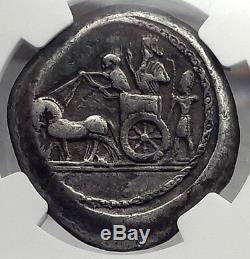
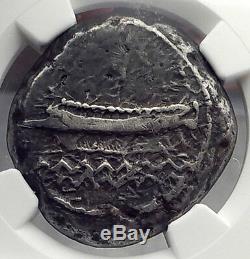
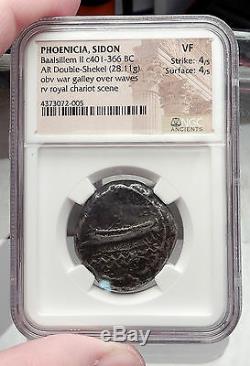
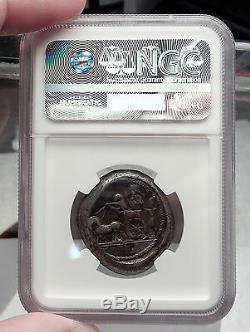
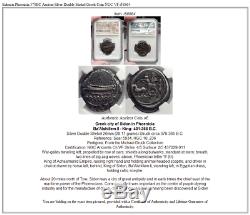

Item: i58864 Authentic Ancient Coin of. Greek city of Sidon in Phoenicia Ba'Alshillem II - King: 401-366 B. Silver Double Shekel 26mm (28.11 grams) Struck circa 370-365 B. Reference: Sear 5934; HGC 10, 236 Pedigree: From the Michael Druck Collection Certification: NGC Ancients Ch VF Strike: 4/5 Surface: 2/5 437029-011 War-galley traveling left, propelled by row of oars; shields along bulwarks, standard at stern; bneath, two lines of zig-zag waves; above, Phoenician letter'9' (B). King of Achaemenid Empire, raising right hand and holding animal-headed sceptre, and driver in chariot drawn by horse left; behind, King of Sidon, Ba'Alshillem II, standing left, in Egyptian dress, holding cultic sceptre.
About 20 miles north of Tyre, Sidon was a city of great antiquity and in early times the chief seat of the maritime power of the Phoenicians. Commercially it was important as the center of purple-dyeing industry and for the manufacture of glass - the art of glass-blowing having been discovered at Sidon in the 1st Century B.
Galleys dominated naval warfare in the Mediterranean from the 8th century BC until development of advanced sailing warships in the 17th century. Galleys fought in the wars of Assyria , ancient Phoenicia , Greece , Carthage and Rome until the 4th century AD. After the fall of the Western Roman Empire galleys formed the mainstay of the Byzantine navy and other navies of successors of the Roman Empire, as well as new Muslim navies. Medieval Mediterranean states, notably the Italian maritime republics, including Venice , Pisa , Genoa and the Ottoman Empire relied on them as the primary warships of their fleets until the 17th century, when they were gradually replaced by sailing warships.
Galleys continued to be applied in minor roles in the Mediterranean and the Baltic Sea even after the introduction of steam propelled ships in the early 19th century. The galley engagements at Actium and Lepanto are among the greatest naval battles in history. , was an empire based in Western Asia , founded by Cyrus the Great , notable for embracing various civilizations and becoming the largest empire of ancient history , spanning at its maximum extent from the Balkans and Eastern Europe proper in the west, to the Indus Valley in the east. It is equally notable for its successful model of a centralised, bureaucratic administration (through satraps under a king) and a government working to the profit of its subjects, for building infrastructure such as a postal system and road systems and the use of an official language across its territories and a large professional army and civil services (inspiring similar systems in later empires), and for emancipation of slaves including the Jewish exiles in Babylon , and is noted in Western history as the antagonist of the Greek city states during the Greco-Persian Wars. The Mausoleum at Halicarnassus , one of the Seven Wonders of the Ancient World , was built in the empire as well.
Sidon has been inhabited since 4000 BC and perhaps as early as Neolithic times (6000 - 4000 BC). It was one of the most important Phoenician cities, and may have been the oldest. From here, and other ports, a great Mediterranean commercial empire was founded. Homer praised the skill of its craftsmen in producing glass and purple dyes.
It was also from here that a colonizing party went to found the city of Tyre. Tyre also grew into a great city, and in subsequent years there was competition between the two, each claiming to be the metropolis ('Mother City') of Phoenicia.
Glass manufacturing, Sidon's most important enterprise in the Phoenician era, was conducted on a vast scale, and the production of purple dye was almost as important. The small shell of the Murex trunculus was broken in order to extract the pigment that was so rare it became the mark of royalty. In AD 1855, the sarcophagus of King Eshmunazar II was discovered.
From a Phoenician inscription on its lid, it appears that he was a "king of the Sidonians, " probably in the 5th century BC, and that his mother was a priestess of Ashtart , the goddess of the Sidonians. In this inscription the gods Eshmun and Baal Sidon'Lord of Sidon' (who may or may not be the same) are mentioned as chief gods of the Sidonians. Ashtart is entitled Ashtart-Shem-Baal'Ashtart the name of the Lord', a title also found in an Ugaritic text.
In the years before Jesus , Sidon had many conquerors: Assyrians , Babylonians , Egyptians , Greeks , and finally Romans. Herod the Great visited Sidon.Both Jesus and Saint Paul are said to have visited it too (see Biblical Sidon below). The city was eventually conquered by the Arabs and then by the Ottoman Turks.
Like other Phoenician city-states, Sidon suffered from a succession of conquerors. At the end of the Persian era in 351 BC, it was invaded by the emperor Artaxerxes III and then by Alexander the Great in 333 BC when the Hellenistic era of Sidon began. Under the successors of Alexander, it enjoyed relative freedom and organized games and competitions in which the greatest athletes of the region participated. In the Necropolis of Sidon, important finds such as the Alexander Sarcophagus, the Lycian tomb and the Sarcophagus of the Crying Women were discovered, which are now on display at the Istanbul Archaeology Museum in Istanbul.
When Sidon fell under Roman domination, it continued to mint its own silver coins. The Romans also built a theater and other major monuments in the city. In the reign of Elagabalus a Roman colonia was established there, and it was given the name of Colonia Aurelia Pia Sidon. During the Byzantine period, when the great earthquake of AD 551 destroyed most of the cities of Phoenicia, Beirut's School of Law took refuge in Sidon. The town continued quietly for the next century, until it was conquered by the Arabs in AD 636. Sidon with a view of the Mediterranean coast. On December 4, 1110 Sidon was sacked in the First Crusade by King Baldwin of Jerusalem and King Sigurd of Norway. It then became the centre of the Lordship of Sidon , an important seigneury in the Kingdom of Jerusalem. During the Crusades it was sacked several times: it was finally destroyed by the Saracens in 1249.In 1260 it was again destroyed by the Mongols. The remains of the original walls are still visible. After Sidon came under Ottoman Turkish rule in the seventeenth century, it regained a great deal of its earlier commercial importance.
After World War I it became part of the French Mandate of Lebanon. During World War II the city, together with the rest of Lebanon, was captured by British forces fighting against the Vichy French , and following the war it became a major city of independent Lebanon.
Following the Palestinian exodus in 1948, a considerable number of Palestinian refugees arrived in Sidon, as in other Lebanese cities, and were settled at the large refugee camps of Ein el-Hilweh and Mieh Mieh. At first these consisted of enormous rows of tents, but gradually houses were constructed. The refugee camps constituted de-facto neighborhoods of Sidon, but had a separate legal and political status which made them into a kind of enclaves. At the same time, the remaining Jews of the city fled, and the Jewish cemetery fell into disrepair, threatened by coastal erosion. Ilya Zlobin, world-renowned expert numismatist, enthusiast, author and dealer in authentic ancient Greek, ancient Roman, ancient Byzantine, world coins & more.
Ilya Zlobin is an independent individual who has a passion for coin collecting, research and understanding the importance of the historical context and significance all coins and objects represent. Send me a message about this and I can update your invoice should you want this method. Getting your order to you, quickly and securely is a top priority and is taken seriously here. Great care is taken in packaging and mailing every item securely and quickly. What is a certificate of authenticity and what guarantees do you give that the item is authentic? You will be very happy with what you get with the COA; a professional presentation of the coin, with all of the relevant information and a picture of the coin you saw in the listing. Additionally, the coin is inside it's own protective coin flip (holder), with a 2x2 inch description of the coin matching the individual number on the COA.Whether your goal is to collect or give the item as a gift, coins presented like this could be more prized and valued higher than items that were not given such care and attention to. Is there a number I can call you with questions about my order?
When should I leave feedback? Please don't leave any negative feedbacks, as it happens sometimes that people rush to leave feedback before letting sufficient time for their order to arrive. The matter of fact is that any issues can be resolved, as reputation is most important to me. My goal is to provide superior products and quality of service.
How and where do I learn more about collecting ancient coins? Visit the "Guide on How to Use My Store" for on an overview about using my store, with additional information and links to all other parts of my store which may include educational information on topics you are looking for. You may also want to do a YouTube search for the term "ancient coin collecting" for educational videos on this topic. The item "Sidon in Phoenicia 370BC Ancient Silver Double Shekel Greek Coin NGC VF i58864" is in sale since Sunday, January 29, 2017. This item is in the category "Coins & Paper Money\Coins\ Ancient\Greek (450 BC-100 AD)".
The seller is "highrating_lowprice" and is located in Rego Park, New York. This item can be shipped worldwide.
- Certification: NGC
- Certification Number: 4373083-012
- Grade: Ch VF
- Composition: Silver

